Complete Solutions to Exercise of chapter Competitive Exam Question of Class 11 book with complete answers and questions
| Class 11 | PHYSICS |
| Chapter | Competitive Exam Question |
| MODERN PUBLICATION | Exercise |
| Number Of Questions | 100 |
| Academic Year | 2023-24 |
Give the magnitude and direction of the net force acting on:- a drop of rain falling down with a constant speed.
View SolutionGive the magnitude and direction of the net force acting on:- a cork of mass 10 g floating on water.
View SolutionGive the magnitude and direction of the net force acting on:- a kite skillfully held stationary in the sky.
View SolutionGive the magnitude and direction of the net force acting on:- a car moving with a constant velocity of `30 km//h` on a rough road.
View SolutionGive the magnitude and direction of the net force acting on:- a high-speed electron in space far from all material objects, and free of electric and magnetic fields.
View SolutionA pebble of mass 0.05 kg is thrown vertically upwards. Give the direction and magnitude of the net force on the pebble:- during its upward motion.
View SolutionA pebble of mass 0.06 kg is thrown vertically upwards. Give the direction and magnitude of the net force on the pebble:- during its downward motion.
View SolutionA pebble of mass 0.07 kg is thrown vertically upwards. Give the direction and magnitude of the net force on the pebble:- at the highest point where it is momentarily at rest. Do your answers change if the pebble was thrown at an angle of `45^@` with the horizontal direction? Ignore air resistance.
View SolutionGive the magnitude and direction of the net force acting on a stone of mass 0.1kg:- just after it is dropped from the window of a stationary train, Neglect air resistance throughout.
View SolutionGive the magnitude and direction of the net force acting on a stone of mass 0.1kg:- just after it is dropped from the window of a train running at a constant velocity of `36 km//h`, Neglect air resistance throughout.
View SolutionOne end of a string of length t is connected to a particle of mass m and the other to a small peg on a smooth horizontal table. If the particle moves in a circle with speed v the net force on the particle (directed towards the centre) is : T is the tension in the string. [Choose the correct alternative].
View SolutionA constant retarding force of 50 N is applied to a body of mass 20 kg moving initially with a speed of `15 m s^(-1)` . How long does the body take to stop ?
View SolutionA constant force acting on a body of mass 3.0 kg changes its speed from `2.0 m s^-1`to `3.5 m s^-1` in 25 s. The direction of the motion of the body remains unchanged. What is the magnitude and direction of the force ?
View SolutionA body of mass 5 kg is acted upon by two perpendicular forces 8 N and 6 N. Give the magnitude and direction of the acceleration of the body.
View SolutionThe driver of a three-wheeler moving with a speed of `36 km//h` sees a child standing in the middle of the road and brings his vehicle to rest in 4.0 s just in time to save the child. What is the average retarding force on the vehicle ? The mass of the three-wheeler is 400 kg and the mass of the driver is 65 kg.
View SolutionA rocket with a lift-off mass 20,000 kg is blasted upwards with an initial acceleration of `5.0 m s^-2`. Calculate the initial thrust (force) of the blast.
View SolutionA body of mass 0.40 kg moving initially with a constant speed of `10 m s^-1` to the north is subject to a constant force of 8.0 N directed towards the south for 30 s. Take the instant the force is applied to be t = 0, the position of the body at that time to be x = 0, and predict its position at t = -5 s, 25 s, 100 s.
View SolutionA truck starts from rest and accelerates uniformly at `2.0 m s^-2`. At t = 10 s, a stone is dropped by a person standing on the top of the truck (6 m high from the ground). What are the:- acceleration of the stone at t = 11s? (Neglect air resistance.)
View SolutionA truck starts from rest and accelerates uniformly at `2.0 m s^-2`. At t = 10 s, a stone is dropped by a person standing on the top of the truck (6 m high from the ground). What are the:- acceleration of the stone at t = 11s? (Neglect air resistance.)
View SolutionA bob of mass 0.1 kg hung from the ceiling of a room by a string 2 m long is set into oscillation. The speed of the bob at its mean position is `1 m s^-1`. What is the trajectory of the bob if the string is cut when the bob is:- at one of its extreme positions,
View SolutionA bob of mass 0.1 kg hung from the ceiling of a room by a string 2 m long is set into oscillation. The speed of the bob at its mean position is `1 m s^-2`. What is the trajectory of the bob if the string is cut when the bob is:- at its mean position.
View SolutionA man of mass 70 kg stands on a weighing scale in a lift which is moving :- upwards with a uniform speed of `10 m s^-1`, what would be the reading on scale?
View SolutionA man weighs 70 kg. He stands on a weighing scale in a lift which is moving?
upwards with a uniform acceleration of `5 ms^-2`.
View SolutionA man weighs 70 kg. He stands on a weighing scale in a lift which is moving?
upwards with a uniform acceleration of `5 ms^-2`.
View SolutionTwo bodies of masses 10 kg and 20 kg respectively kept on a smooth, horizontal surface are tied to the ends of a light string, a horizontal force F = 600 N is applied to:-B along the direction of string. What is the tension in the string in each case?
View SolutionTwo bodies of masses 10 kg and 20 kg respectively kept on a smooth, horizontal surface are tied to the ends of a light string, a horizontal force F = 600 N is applied to:-B along the direction of string. What is the tension in the string in each case?
View SolutionA nucleus is at rest in the laboratory frame of reference. Show that if it disintegrates into two smaller nuclei the products must move in opposite directions.
View SolutionTwo billiard balls each of mass 0.05 kg moving in opposite directions with speed `6 m s^-1` collide and rebound with the same speed. What is the impulse imparted to each ball due to the other ?
View SolutionA shell of mass 0.020 kg is fired by a gun of mass 100 kg. If the muzzle speed of the shell is `80 m s^-1`, what is the recoil speed of the gun ?
View SolutionA batsman deflects a ball by an angle of `45^@` without changing its initial speed which is equal to `54 km//h`. What is the impulse imparted to the ball ? (Mass of the ball is 0.15 kg.)
View SolutionIf, in Exercise 5.21, the speed of the stone is increased beyond the maximum permissible value, and the string breaks suddenly, which of the following correctly describes the trajectory of the stone after the string breaks :- the stone moves radially outwards.
View SolutionIf, in Exercise 5.21, the speed of the stone is increased beyond the maximum permissible value, and the string breaks suddenly, which of the following correctly describes the trajectory of the stone after the string breaks :- the stone flies off tangentially from the instant the string breaks.
View SolutionIf, in Exercise 5.21, the speed of the stone is increased beyond the maximum permissible value, and the string breaks suddenly, which of the following correctly describes the trajectory of the stone after the string breaks :- the stone flies off at an angle with the tangent whose magnitude depends on the speed of the particle ?
View SolutionExplain why:- a horse cannot pull a cart and run in empty space.
View SolutionExplain why:- passengers are thrown forward from their seats when a speeding bus stops suddenly.
View SolutionExplain why:- it is easier to pull a lawn mower than to push it.
View SolutionExplain why:- a cricketer moves his hands backwards while holding a catch.
View SolutionA stone of mass mtied to the end of a string revolves in a vertical circle of radius R. The net forces at the lowest and highest points of the circle directed vertically downwards are : [Choose the correct alternative] `T_1 and v_1` denote the tension and speed at the lowest point. `T_2 and v_2` denote corresponding values at the highest point.

View SolutionA helicopter of mass 1000 kg rises with a vertical acceleration of `15 m s^-2`. The crew and the passengers weigh 300 kg. Give the magnitude and direction of the:- force on the floor by the crew and passengers,
View SolutionA helicopter of mass 1000 kg rises with a vertical acceleration of `15 m s^-2`. The crew and the passengers weigh 300 kg. Give the magnitude and direction of the:- action of the rotor of the helicopter on the surrounding air,
View SolutionA helicopter of mass 1000 kg rises with a vertical acceleration of `15 m s^-2`. The crew and the passengers weigh 300 kg. Give the magnitude and direction of the:- force on the floor by the crew and passengers,
View SolutionA stream of water flowing horizontally with a speed of `15m s^-1` gushes out of a tube of cross-sectional area `10^-2 m^2`, and hits a vertical wall nearby. What is the force exerted on the wall by the impact of water, assuming it does not rebound ?
View SolutionTen one-rupee coins are put on top of each other on a table. Each coin has a mass m Give the magnitude and direction of:- the force on the 7th coin (counted from the bottom) due to all the coins on its top,
View SolutionTen one-rupee coins are put on top of each other on a table. Each coin has a mass m Give the magnitude and direction of:- the force on the 7th coin by the eighth coin,
View SolutionTen one-rupee coins are put on top of each other on a table. Each coin has a mass m Give the magnitude and direction of:- the reaction of the 6th coin on the 7th coin.
View SolutionAn aircraft executes a horizontal loop at a speed of `720 km//h` with its wings banked at `15^@`. What is the radius of the loop ?
View SolutionA train runs along an unbanked circular track of radius 30 m at a speed of `54 km//h`. The mass of the train is `10^6 kg`. What provides the centripetal force required for this purpose — Hie engine or the rails ? What is the angle of banking required to prevent wearing out of the rail ?
View SolutionA train runs along an unbanked circular track of radius 30 m at a speed of `54 km//h`. The mass of the train is `10^6 kg`. What provides the centripetal force required for this purpose — Hie engine or the rails ? What is the angle of banking required to prevent wearing out of the rail ?
View SolutionA train runs along an unbanked circular track of radius 30 m at a speed of `54 km//h`. The mass of the train is `10^6 kg`. What provides the centripetal force required for this purpose — Hie engine or the rails ? What is the angle of banking required to prevent wearing out of the rail ?
View SolutionA block of mass 15 kg is placed on a long trolley. The coefficient of friction between the block and the trolley is 0.18. The trolley accelerate from rest with `0.5 ms^-2` for 20 s and then moves with unifrom velocity. Discuss the motion of the block as viewd by an observer with the trolley.
View SolutionA block of mass 15 kg is placed on a long trolley. The coefficient of friction between the block and the trolley is 0.18. The trolley accelerate from rest with `0.5 ms^-2` for 20 s and then moves with unifrom velocity. Discuss the motion of the block as viewd by an observer with the trolley.
View SolutionA disc revolves with a spped of `33 (1/3) rev// min`, and has a radius of 15 cm. Two coins are placed at 4 cm and 14 cm away from the centre the record. If the co-effcient of friction between the coins and the record is 0.15, which of the coins will revolve with the record?
View SolutionA 70 kg man stands in contact against the ineer wall of a hollow cylindrical drum of radius 3 m rotating about its vertical axis with `200 rev//min`. The coeffcient of friction between the wall and his clothing is 0.15. What is the minimum rotational speed of the cylinder to enable the man of remain stuck to the wall ( without falling) when the floor ids suddenly removed?
View SolutionA thin circular loop of radius R rotates about its vertical diameter with an angular frequency ` omega`. Show that a small bead on the wire loop rem ains at its lowermost point for `omega oversetlarrsqrt(g/R)` What is the angle made by the radius vector joining the centre to the bead with the vertical downward direction for `omega = sqrt (2g/R)`? neglect friction.
View SolutionWhen a constant force is applied to a body, it moves with uniform
View SolutionAristotle taught that a constant force was required to produce a constant velocity and from this he concluded that in the absence of force, boodies would come to rest. How do you explain, each of the situations in a constant force seems to produce a constant velocity in the light of Newton's law of motion ?
View SolutionDescribe how a man weighing 980 N might be able to slide down a rope that can support a weight of only 755 N.
View SolutionA man weighing 980 N might be able to slide down a rope that can support a weight of only 755 N.What will be his minimum velocity after sliding 8 m with acceleration 2.25 meter per (second square)?
View SolutionAn aircraft oof masss 300 kg flies at a speed of `360 h^(-1)` and makes a turn of radius 2500 m. Determine the aircraft's bank angle and d the magnitude of the lift needed to perform the turn in a hhorizontal plane. The lift is always directed perpendicular to the plane of the aircraft wings.
View SolutionWhen a force of constant magnitude always acts perpendicular to the motion of a particle then:
View SolutionA body of mass 3.513 kg is moving along the X-axis with a speed of `5.00 m s^(-1)`. The magnitude of its momentum is recorded as
View SolutionA rocket with a lift-off mass 20,000 kg is blasted upwards with an initial acceleration of `5.0 m s^-2`. Calculate the initial thrust (force) of the blast.
View SolutionA block of mass m is connected to another block of mass M by a spring (massless) of spring constant k. The blocks are kept on a smooth horizontal plane. Initially, the blocks are at rest and the spring is unstretched. Then a constant force F starts acting on the block of mass M to pull it. Find the force on the block of mass m.
View SolutionA block of mass M is pulled along a horizontal frictionless surface by a rope of mass `m`. If a force P is applied at the free end of the rope, the force exerted by the rope on the block
View SolutionA particle of mass 0.3 kg is subjected to a force `F=-kx` with `k=15 N m^(-1)`. What will be its initial acceleration, if it is released from a point 20 cm away from the origin ?
View SolutionA ball of mass 0.2 kg is thrown vertically upwards by applying a force by hand. If the hand moves 0.2 m while applying the force and the ball goes upto 2 m height further, find the magnitude of the force. Take `g=10 m s^(-2)`.
View SolutionA player catches a cricket ball of mass of 0.15 kg moving with a speed of `20 ms^(-1)`. The process of catching is completed in 0.1 s. The average force exerted by the player is
View SolutionThe figure shows
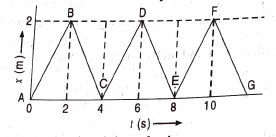 the position-time `(x-t)` graph of one dimensional motion of a body of mass 0.4 kg. The magnitude of each impulse is
the position-time `(x-t)` graph of one dimensional motion of a body of mass 0.4 kg. The magnitude of each impulse is
View SolutionA machine gun fires a bullet of mass 40 g with a velocity `1200 m s^(-1)`. The man holding it, can exert a maximum force of 144 N on the gun. How many bullets can he fire per second at the most ?
View SolutionTwo frictionless inclined planes making an angle of `30^@` and `606@` with the vertical are shown in the figure.
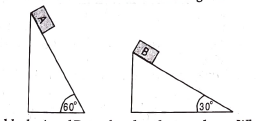 Two blocks A and B are placed on the two planes. What is the relative vertical acceleration of A w.r.t. B ?
Two blocks A and B are placed on the two planes. What is the relative vertical acceleration of A w.r.t. B ?
View SolutionA block is kept on a frictionless inclined surface with angle of inclination `alpha`. The incline is given an acceleration `a` to keep the block stationary.
 Then, `a` is equal to
Then, `a` is equal to
View SolutionA lift is moving down with acceleration `a`. A man in the lift drops a ball inside the lift. The acceleration of the ball as observed by the man in the lift and a man standing stationary on the ground are respectively.
View SolutionA light spring balance hangs from the hook of the other light spring balance and a block of mass M kg hangs from the former one. Then, the true statement about the scale reading is :
View SolutionA spring balance is attached to the ceiling of a stationary lift. A man suspends a block from the hook of the spring balance and the balance reads 98 N. What will be the reading of the spring balance, if the lift starts moving downward with an acceleration of `2ms^(-2)`?
View SolutionThree forces start acting simultaneously on a particle moving with velocity `vecv`. These forces are represented in magnitude and direction by the three sides of a triangle ABC (as shown).
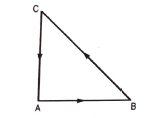 The particle will now move with velocity :
The particle will now move with velocity :
View SolutionWhen forces `F_1,F_2` and `F_3` are acting on a particle of mass `m` such that `F_2` and `F_3` are mutually perpendicular, then the particle remains stationary. If the force `F_1` is now removed then the acceleration of the particle is :
View SolutionThree identical blocks of masses `m=2kg` are drawn by a force `F=10.2N` with an acceleration of `0.6 ms^(-2)` on a frictionless surface. What is the tension (in N) in the string between the blocks B and C ?

View SolutionTwo masses `m_1=5 kg` and `m_2=4.8kg` tied to a string are hanging over a light frictionless pulley. What is the acceleration of the masses, when lift is free to move ? Given, `g=9.8 m s^(-2)`.
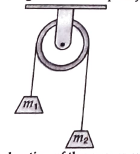
View SolutionA light string passing over a smooth light pulley connects two blocks of masses `m_1` and `m_2` (vertically). If the acceleraton of the system is `g//8`, find the ratio of the two masses.
View SolutionA marble block of mass 2 kg lying on ice, when given a velocity of `6 m^(-1)`, is stopped by friction in 10 s. Then the coefficient of friction is :
View SolutionA block rests on a rough inclined plane making an angle of `30^@` with the horizontal. The coefficient of static friction between the block and the plane is 0.8. If the frictional force on the block is 10 N, the mass of the block (in kg) is (`g=10 m s^(-2)`) :
View SolutionA horizontal force of 10 N is necessary to just hold a block stationary against a wall. The coefficient of friction between the block and the wall is 0.2. the weight of the block is :

View SolutionThe upper half of an inclined plane with inclination `theta` is perfectly smooth, while the lower half is rough. A bdy starting from rest at the top will again come to rest at the bottom, find the coefficient of friction for the lower half.
View SolutionA smooth block is released at rest on a `45^@` incline an dthen slides a distance `d`. The time taken to slide is `n` times as much to slide on rough incline than on a smooth incline. The coefficient of friction is :
View SolutionWhen a force of constant magnitude always acts perpendicular to the motion of a particle then:
View SolutionAn annular ring with inner and outer radii `R_1` and `R_2` is rolling without slipping with a uniform angular speed. The ratio of the forces `F_1//F_2` experienced by two identical particles situated on the inner and outer parts of the ring is
View SolutionThe minimum velocity (in `m s^(-1)`) with which a car driver must traverse a flat curve of radius 150 m and coefficient of friction 0.6 to avoid skidding is :
View SolutionA point P moves in counter-clockwise direction on a circular path as shown in the figure. The movement of P is such that it sweeps out a length `S=t^3+5`, where S is in metres and `t` in seconds. The radius of the path is 20 m. The acceleration of P, when `t=2 s` is nearly
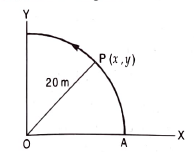 .
.
View SolutionFor a particle in circular motion, the acceleration `veca` at a point `(R, theta)` on the circle of radius R is (Here, `theta` is measured from the X-axis)
View SolutionA ball is dropped from a spacecraft revolving around the earth at a height of 120 km. What will happen to the ball ?
View Solution10 N force applied on a body produces in it an acceleration of `1 m s^(-2)`. The mass of the body is
View SolutionA force of 6 N acts on a body of mass 1 kg and at rest. During this time, the body attains a velocity of `30 m s^(-1)`. The time for which the force acts on the body is
View SolutionA particle of mass `m` is projected with velocity `v` making an angle of `45^@` with the horizontal. When the particle lands on the level ground, the magnitude of the change in momentum will be
View SolutionA force vector applied on a mass is represented as `vecF=6hati-8hatj+10hatk` and accelerates with `1 m s^(-2)`. What will be the mass of the body ?
View SolutionAn object of mass 3 kg is at rest. Now a force of `vecF=(6t^2hati+4t hatj)N` applied on the object. Then, the velocity (in `m s^(-1)`) of object at `t=3s` is
View SolutionIf the force on a rocket moving with a velocity of `300 m s^(-1)` is 210 N, then the rate of combustion of the fuel is
View SolutionA cricket catches a ball of mass 150 g in 0.1 s moving with a speed of `20 ms^-1`. Then the experiences a foce of
View SolutionA 0.5 kg ball moving with a speed of `12 m s^(-1)` strikes a hard wall at an angle of `30^@` with thw wall. It is reflected with the same speed at the same angle. If the ball is contact with the wall for 0.25 s, the average force acting on the wall is
View SolutionA 3 kg ball strikes a heavy rigid wall with a speed of `10 m s^(-1)` at an angle of `60^@`. It gets reflected with the same speed and angle as shown in the figure. If the ball is in contact with the wall for 0.2 s, what is the average force exerted on the ball by the wall ?

View SolutionThree forces acting on a body are as shown in figure . To have the resultant force only along the X-direction, the magnitude of the minimum additional force needed is
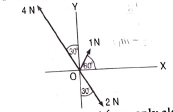
View Solution
Exercise questions and complete solutions for chapter Competitive Exam Question of MODERN PUBLICATION of Class 11